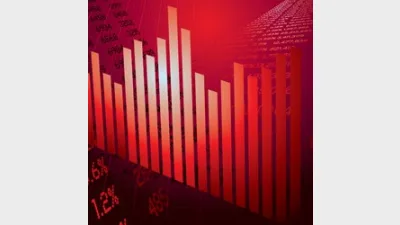Market volatility and navigating investor pessimism



ipac's Jeff Rogers details the thought processes behind looking through the prevailing investor pessimism and reaffirming the efficacy of long-term strategies.
Pessimism is in the ascendency today.
You can observe that by scanning articles on economies and markets in the press where there is an evident competition among editors for the most apocalyptic headline.
You can infer it from the negative real yields on long-term bonds in the US. Safety is the trade of the day.
Even yields on Commonwealth Government bonds have been pushed to historical lows in the rush to hide from uncertainty.
Ultimately, this pessimism creates an opportunity for those who do not believe the global economy faces inevitable disaster.

However, we need to stay invested in our equity portfolios if we are to grasp that opportunity.
And it is not easy to stay invested during protracted periods of share market volatility, at which time the natural behavioural response is to abandon our long-term strategy in the pursuit of near-term respite.
Changing strategy in response to temporary setbacks is one of the biggest investment mistakes we can make.
When times are tough, quality advice helps clients fight this destructive impulse. In order to be most effective, financial advisers need to be positioned to confidently address client concerns.
Be clear on objectives
The appropriate place to start is to reaffirm the goals which our investment strategy has been designed to achieve.
While everyone's circumstances are different, the key objective for the majority of our clients is to achieve and preserve an acceptable future real standard of living in retirement.
It is our assessment that the most important source of return to help clients achieve these longer-term goals is a sustainable income stream from share dividends.
Be clear on what is important
It is critical to distinguish between a temporary loss of value and a permanent loss of capital.
The former often creates an opportunity, while the latter is something we work hard to avoid through thoughtful diversification across a portfolio of quality companies.

We should not be frightened by market volatility or a temporary loss in value.
In the short-term, market returns are determined by largely unpredictable shifts in investor sentiment – fear and greed.
But over the long-term, sentiment diminishes in importance and the impact of corporate performance rises in its influence on returns.
Given the dominant objective for most clients, the trajectory of corporate cashflows and dividends is more important than short-term movements in share prices.
Understand what is currently “priced” in the market
Investors and policymakers are acutely aware of the threats facing the global economy and financial system.
This is in stark contrast to the conditions prevailing prior to the onset of the global financial crisis, at which time investors were expressing considerable optimism.
Today, fear is the dominant force driving market prices. Investors still have vivid memories of the financial crisis and dread getting caught out again.
Investors demand a significant margin of safety in uncertain times. So it is of little surprise that valuations are depressed in many share markets.
While it would be wrong to claim that a worst-case scenario is already priced in markets, the consensus is deeply pessimistic.
If the news in the period ahead turns out not to be quite as bad as currently feared, then market prices will rise.
It is important to be aware that policymakers, who were blindsided by the events that unfolded four years ago, have had a good deal of time to work out how they might deal with financial dislocations, should they emerge.
Focus on what drives the fundamentals
In the short-term, share prices are likely to continue to exhibit ongoing bouts of volatility as deleveraging continues to be the dominant policy imperative in advanced economies.
But that is a short-term issue.
{^image|(width)600|(height)382|(mouseoverheight)395|(url)http://media.cirrusmedia.com.au/Money_Media_Library/Print Images/120628/MMJUN28_12p23_t3_1.jpg"float: right; width: 200px; margin: 5px">
The current income available for spending from the share strategy exceeds that of the term deposits, and is likely to do so for quite some time.
The constructive outlook for corporate fundamentals and the low valuations of the current market combine to produce attractive share market yields.
These yields represent a compelling opportunity for clients focussed on building sustainable spending power in the future.
Nowhere, is this more evident than in Australia where the share market currently has a forecast cash dividend yield in excess of 5% and a gross yield which incorporates the value of imputation credits of around 7 per cent.
This yield is well above prevailing interest rates on cash and term deposits.
Think about two different investment strategies. One strategy is to purchase a term deposit, spend the income, and then rollover the capital at maturity into a new term deposit.
The other strategy is to buy a diversified portfolio of Australian shares, spend the dividends and the imputation credits, while maintaining capital invested in the underlying portfolio.
Many people regard the first strategy as safe while the second as risky. That is because the second strategy is exposed to loss of value in the short-term, while the former is not.
Clients seeking to build and preserve an acceptable real standard of living in retirement should form a different conclusion.
Viewed through their lens, the income stream available for spending from the equity strategy is far more stable and reliable than that from the term deposit strategy.
In addition, the income stream from the equity strategy is likely to grow at least as fast as inflation over time, while the spending power generated by term deposits is most likely to decline.
Critically, the current income available for spending from the share strategy exceeds that of the term deposits, and is likely to do so for quite some time.
Clients hoping for a rebound in share value are currently being paid to wait for that price adjustment.
Conclusion
The most recent bout of fear in share markets happened to coincide with the Diamond Jubilee celebrations for the Queen.
Perhaps the best advice we can provide investors at present is to follow the catch-cry printed on posters by the UK Government during the Second World War: “Keep Calm and Carry On”.
Jeff Rogers is chief investment officer at ipac.
Recommended for you
In this episode of Relative Return Insider, host Keith Ford and AMP chief economist Shane Oliver discuss the latest shock consumer price index numbers, which rose to 3.8 per cent in October, as well as the shifting US market and calls for super funds to invest in infrastructure projects.
In this episode of Relative Return Insider, host Keith Ford and AMP chief economist Shane Oliver discuss the Reserve Bank of Australia’s cautious stance in response to persistent inflation, subdued growth prospects, and political shifts affecting the nation’s journey towards net zero emissions.
In this episode of Relative Return, host Laura Dew speaks with Rachel White, head of financial adviser services at Vanguard about how advisers can help Australians to feel confident in retirement.
In this episode of Relative Return Insider, host Keith Ford and AMP deputy chief economist Diana Mousina take a look at the Reserve Bank’s unanimous decision to leave rates on hold on Melbourne Cup Day and whether future cuts are still on the cards.







